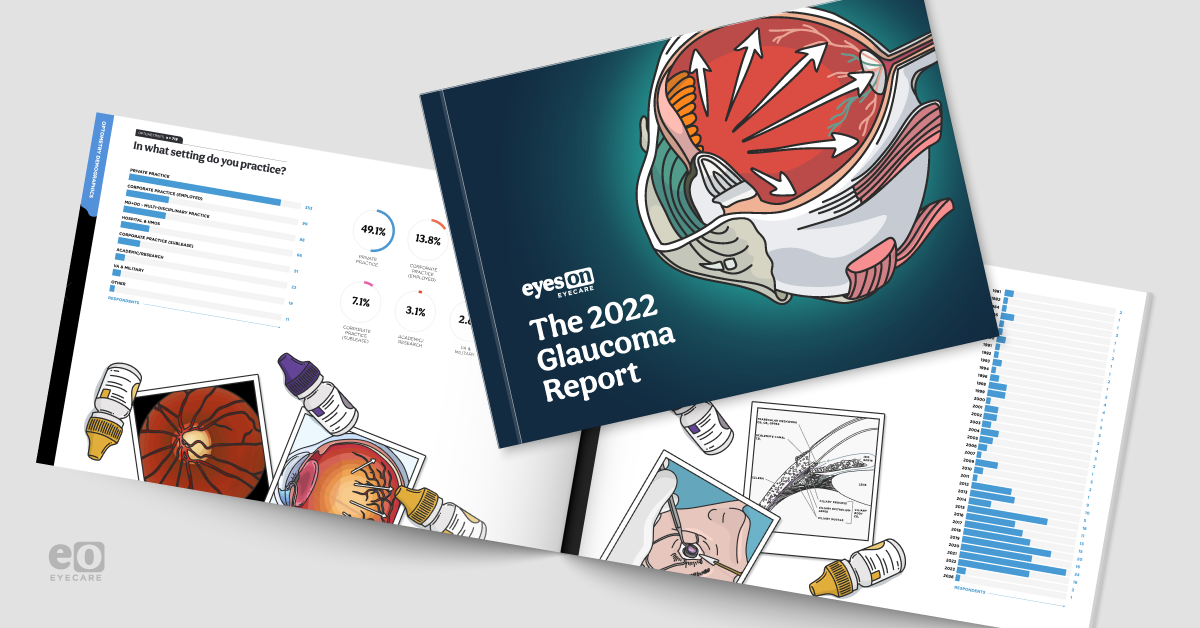With that in mind, it’s more important than ever for eyecare practitioners around the world to expand their knowledge of
glaucoma diagnosis, treatment, and management. Eyecare has come a long way, and eyecare practitioners are better equipped to confront this disease than ever before.
In April of 2022, the Eyes On Eyecare team surveyed over 750 eyecare practitioners from around the world, including 719
optometrists and 67 ophthalmologists across North America and beyond. We sought to understand how ECPs are approaching glaucoma. The result of this survey is the 2022 Glaucoma Report, and as with all Eyes On Eyecare reports, it is absolutely free to download!
The 2023 Glaucoma Report is now available!
Download your free copy of the report to learn how your colleagues are approaching this disease. Download now
Download the 2022 Glaucoma Report now or keep reading for a sneak peek at the findings!
Download the 2022 Glaucoma Report
Get free access to over 30 pages of data!
The 2022 Glaucoma Report covers:
- Confidence in diagnosing, managing, and treating glaucoma: How comfortable are optometrists and ophthalmologists diagnosing glaucoma? How comfortable are they with treating and managing the disease?
- Glaucoma prevalence and focus: How many of your patients have been diagnosed with glaucoma? How important is glaucoma to your practice?
- Go-to treatments for glaucoma: What are the top first-line and second-line treatments for glaucoma? How comfortable are optometrists and ophthalmologists with the variety of glaucoma treatments available?
- Referrals and co-management: What do optometrist and ophthalmologists think about the co-management process for glaucoma? How many patients are they referring to other specialists and why?
- And more!
Confidence in treating glaucoma is high among ophthalmologists and optometrists
This year, optometrists estimated that on average 17% of their patients had been diagnosed with glaucoma, while ophthalmologists estimated that roughly 37% of their patients had been similarly diagnosed. Overall confidence in diagnosis was high among both populations, with an average 7.48 out of 10 among optometrists and 7.72 out of 10 among ophthalmologists.
Similarly, ODs and ophthalmologists reported confidence in treating and managing glaucoma, but optometrists were much less confident in the practice management aspects of glaucoma than their colleagues in ophthalmology (6.5/10 versus 7.25/10).
Topical medications are the go-to first-line treatment for glaucoma, with SLT a favorite among second-line treatments
This year, we followed up with optometrists about their favorite second-line treatments for mild to moderate open angle glaucoma. Last year, following best practices in
glaucoma treatment and management, topical medication were the go-to first-line treatment for glaucoma among optometrists, just as they were this year among ophthalmologists. For both optometrists and ophthalmologists, SLT is the most popular second-line treatment for glaucoma.
With
SLT growing in popularity, we wondered if optometrists will begin turning to it more as a first-line treatment, especially considering that the number one reason optometrists are not writing more prescriptions for branded medications is due to the cost of those medications.
Optometrists and ophthalmologists want a better co-management process
When it comes to
referrals and co-management, it was interesting to see that both optometrists and ophthalmologists were lukewarm on their practices’ co-management processes, with a 6.71/10 from optometrists and an average 6.94/10 for ophthalmologists.
While these numbers aren’t terrible, they can certainly be improved—especially since optometrist respondents reported referring nearly 30% of their glaucoma patients out to an ophthalmologist,
primarily for surgical procedures or patients who were not responding to topical medications.
The 2023 Glaucoma Report is now available!
Download your free copy of the report to learn how your colleagues are approaching this disease. Download now


